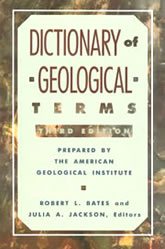Geological Terms Beginning With "T"
For terms beginning with other letters, please click below
|
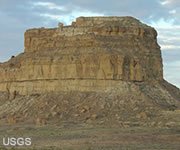
Talus
An accumulation of angular rock debris at the base of a cliff or steep slope that was produced by physical weathering. The image shows a portion of the talus apron that surrounds Fajada Butte in Chaco Valley, New Mexico.
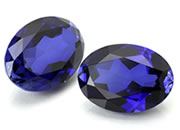
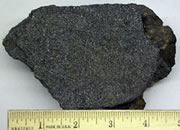
Tar Sand
Also known as "oil sand." A porous sand or sandstone that contains asphalt or bitumen within its pore spaces. Sometimes the name "oil sand" is used for a deposit in which the hydrocarbon is in a liquid form, and the name "tar sand" is reserved for those deposits in which the hydrocarbon is in the form of solid asphalt or bitumen.
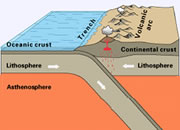
Tectonics
The study of the outermost portion of the Earth, from the surface down to the base of the lithosphere, along with the processes that produce large-scale movement and deformation within this zone.
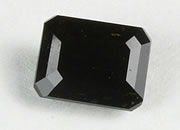
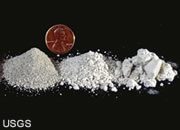
Tephra
A general term used for fragments of igneous rock and lava of any size that have been blown into the air by the force of a volcanic eruption. Tephra can include large blocks and bombs and particle sizes down to volcanic dust. Larger materials generally fall near the vent, but dust-size particles can be carried for thousands of miles by wind.

Terminal Moraine
A mound of unsorted glacial till that usually crosses a valley and marks the furthest advance of a glacier. Also called an "end moraine." The photo shows the terminal moraine of the Nellie Juan Glacier near Prince William Sound, Alaska. The two-mile-long lagoon between the terminal moraine and the glacier's terminus is filled with seawater.
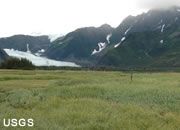
Terminus
The lower end of a glacier, often called the "snout." The photo shows the terminus of the Pedersen Glacier, located in Kenai Fjords National Park, Alaska.
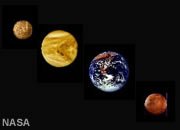
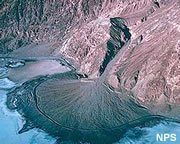
Terrigenous Sediment
Sediment that is derived from the weathering of rocks that are exposed above sea level. These sediments typically consist of clay, silt, sand, and gravel and are deposited above sea level or carried by rivers, glaciers, or wind into the ocean. The image shows terrigenous sediment deposited on the Badwater alluvial fan of Death Valley.

Texture
The visible characteristics of a rock which include its grain size, grain orientation, rounding, angularity, porosity, foliation, crystallinity, presence of vesicles, and other physical attributes of the mineral grains and matrix that make up the rock. The image shows the texture of a hand-specimen of conglomerate that can be seen at the top of our article on conglomerate.

Thermal Pollution
Water quality is not defined by chemistry alone. If natural waters are withdrawn for use, they should be returned to the environment at approximately the same temperature. An increase or decrease in temperature can have an adverse effect upon plants, animals, and chemical balances. Returning water to a stream at a different temperature than the current temperature of the water is known as thermal pollution. For example, coal-fired power plants use water in the production of steam that turns turbines. That water is then cooled in large cooling towers before it is returned to the environment. The image shows a steam electric power plant where thermal release must be monitored and controlled.
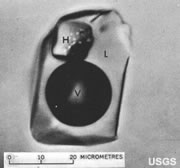
Three-Phase Inclusion
A void within a mineral that contains three different states of matter: a liquid, a vapor, and a solid. The photo shows an inclusion in quartz that contains a liquid (L), a vapor bubble (V), and a crystal of halite (H).
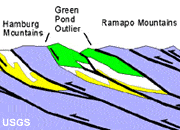
Thrust Fault
A reverse fault that has a dip of less than 45 degrees. A reverse fault is a fault with vertical movement and an inclined fault plane. The block above the fault has moved upwards relative to the block below the fault. Thrust and reverse faults are the typical structural style of convergent plate boundaries and portions of the crust that are under compression.

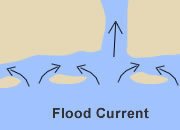
Tidal Current
Currents of water that are produced in response to a rising or falling tide. These currents can flow into or out of a bay, delivering the rising water as high tide approaches, or removing the falling water after high tide has passed. (See "ebb current" and "flood current.")
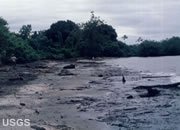
Tidal Flat
A broad flat area, very close to sea level, that is flooded and drained with each rise and fall of the tide.
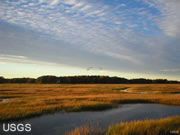
Tidal Marsh
A marsh along a coastline that receives an inflow of ocean water during high tide and is populated by salt-tolerant vegetation. Also known as a "salt marsh." The photo is of a marsh in the Plum Island Estuary that researchers believe will be submerged this century as sea levels rise.

Tidal Wave
A term that is incorrectly used in reference to a tsunami or a storm surge. Tsunamis have nothing to do with the tides. Storm surges may sometimes combine with a tide, but the word "tidal wave" is inappropriate in any usage.
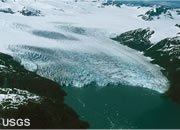
Tidewater Glacier
A glacier with a terminus that ends in a body of water that is influenced by tides. These glaciers may calve and produce icebergs that are carried away at ebb tide.

Tiffany Stone
Also known as "bertrandite," Tiffany stone is a beautiful material that is thought to be an opalized fluorite. Found at one beryllium mine site in Utah.
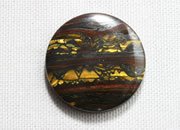
Tiger iron
Tiger iron is a rock composed of alternating bands of silver hematite, gold tiger's-eye, and red jasper. It is cut into attractive and interesting cabochons, beads, spheres, and other lapidary items.
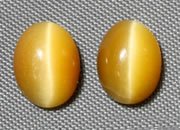
Tiger's-eye
Tiger's-eye is a material that forms when quartz replaces crocidolite. When it is cut into a cabochon with its fibrous structure parallel to the bottom of the stone, a chatoyance, or cat's-eye effect, is produced.

Till
An unsorted sediment deposited directly by a glacier as it melts in retreat and not reworked by meltwater.
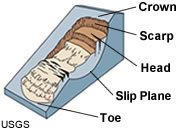
Toe
A bulge of soil that develops at the base of a landslide. It occurs where the moving mass overruns the surface exposure of the slip plane. Often people see a mound of soil develop on a slope and grade it level or remove it. Removing the toe of a slide can cause the slide to accelerate because the toe provides support.
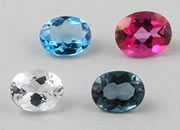
Topaz
Topaz is a popular gem. It is usually clear to amber in color when mined. It can be heated, coated, or irradiated to produce other colors that include "Swiss blue," "London blue," bright pink, and soft pink.

Topographic Map
A map that shows the change in elevation over a geographic area through the use of contour lines. The contour lines trace points of equal elevation across the map. See also: contour line and contour map.

Topography
The shape of Earth's surface or the geometry of landforms in a geographic area.

Tourmaline
Tourmaline is a silicate mineral that occurs in a wide range of attractive colors. It is a very durable gemstone that is popular with jewelry makers.

Trace Element
An element that is present in very small quantities. Trace elements in a mineral or a gemstone are elements that are not essential components of that mineral's chemical composition. For example, trace amounts of chromium can produce a green color in beryl, and when enough chromium is present to produce a rich green color, the material can be called "emerald."
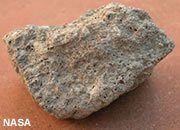
Trachyte
A fine-grained extrusive igneous rock that contains large amounts of potassium feldspar and minor amounts of mafic minerals, often as phenocrysts. The extrusive equivalent of syenite.
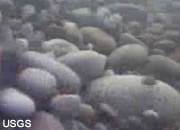
Traction
Transport of sediment by wind or water in which the sediment remains in contact with the ground or bed of the stream, moving by rolling or sliding.
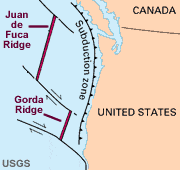
Transform Fault
A strike-slip fault that connects offsets in a mid-ocean ridge, or links sections of two other faults.
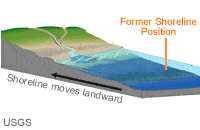
Transgression
An advance of the sea over land areas. Possible causes include a rise in sea level or subsidence.
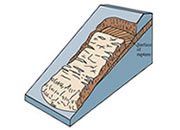
Translational Slide
A slope failure in which the moving mass travels along a roughly planar surface with little rotation or backward tilting.
|
Dictionary of Geological Terms - Only $19.99 All scientific disciplines have an essential vocabulary that students and professionals must understand to learn and communicate effectively. A geology dictionary that is used regularly is one of the most important tools for developing professional competence. A good dictionary should be on the desk of every geologist and within easy reach. This dictionary is compact and inexpensive at only $19.99. More information. |
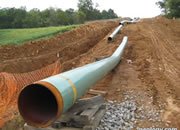
Transmission Pipeline
A pipeline that carries natural gas from a region where it is produced to a region where it is stored or consumed.
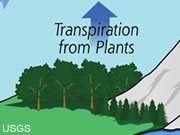
Transpiration
A process of plants removing water from the soil and releasing it into the atmosphere through their leaves.

Transverse Dunes
Sand dunes that are oriented at right angles to the direction of the prevailing wind. These form where vegetation is sparse and the sand supply is abundant.
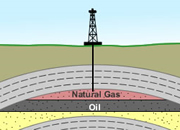
Trap
A sedimentary or tectonic structure where oil and/or natural gas has accumulated. These are structural highs where a porous rock unit is capped by an impermeable rock unit. Oil and gas trapped within the porous rock unit migrate to a high point in the structure because of their low density.
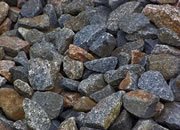
Trap Rock
"Trap rock" is a construction industry term used for any dark-colored igneous rock that is used to make crushed stone. The name comes from the Swedish word "trappa" which means "stair steps," a reference to the terraced landscape that is found in geologic areas like the Columbia River Plateau or the Hawaiian Islands, which are underlain by layered basalt flows or layered intrusions such as sills.
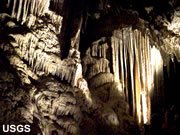
Travertine
Calcium carbonate deposits that form in caves and around hot springs where carbonate-bearing waters are exposed to the air. The water evaporates, leaving a small deposit of calcium carbonate.
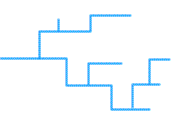
Trellis Drainage
A drainage pattern in which streams intersect at right angles. This forms in areas of long parallel valleys such as in folded mountain belts. Rivers occupy the valleys, and tributary streams join them at right angles.

Trench
A long, narrow, deep depression in the ocean floor that parallels a convergent plate boundary involving at least one oceanic plate.
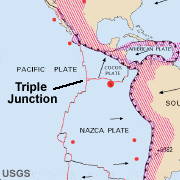
Triple Junction
A point where three lithospheric plates meet. Triple junctions can be areas of unusual tectonic activity due to the differential motions of the three intersecting plates.

Tripping
Tripping is the work of pulling, removing, and replacing all of the pipe down the hole of an oil or gas well when the bit or other piece of the drill string must be changed. "Tripping out" is the process of removing the pipe, and "tripping in" is the process of replacing it.
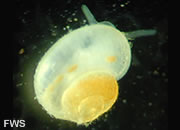
Troglobites
Small creatures that have adapted to a permanent life in a cave. They are so well adapted to life in a cave that they would be unable to survive in the surface environment. To survive in the darkness, troglobites have highly developed senses of hearing, touch, and smell. Many troglobites have lost their sight and their pigments.
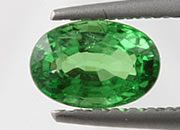
Tsavorite Garnet
Tsavorite is a calcium-rich garnet known for its brilliant green color. It sometimes serves as an alternative stone to emerald. It is the most important green garnet and one of the rarest and most valuable colored stones.
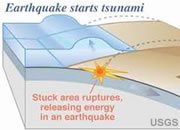
Tsunami
A large gravity wave produced by a sudden displacement of a large volume of water. The displacement is usually caused by an earthquake, but it can be caused by submarine landslides, subaerial landslides that enter water, explosive volcanic eruptions, caldera collapses, iceberg calving, and asteroid impacts. These events suddenly depress or elevate a large volume of water, then gravity causes the energy of that displacement to propagate away from the source at a high rate of speed, often as fast as 500 miles per hour and often travelling across entire ocean basins. The waves have a very long wavelength of up to 100 miles, but their amplitude is typically so low that they can travel beneath ships without being noticed. Most tsunamis originate in the ocean, but they can be produced in lakes, bays, and rivers. When they enter shallow water, the energy of the wave begins to drag on the bottom and that slows the front of the wave, while the back of the wave piles up behind it, reaching heights of up to 100 feet.
Some people use the term “tidal wave” instead of “tsunami,” but that is incorrect because a tsunami has nothing to do with tides. The term “seismic sea wave” is correct if the tsunami is produced by an earthquake.

Tuff
An igneous rock composed of pyroclastic materials that have been ejected from a volcano, often during the formation of a maar. In many instances these fragments are still hot when they land, producing a "welded" rock mass or a "welded tuff."
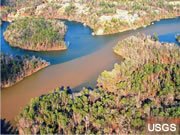
Turbid
Water that has been disturbed and is carrying suspended material, reducing its clarity. The word is often used in reference to lake water that has been muddied by a stream carrying in a load of suspended sediment. Also known as "roiled." The photo shows a heavy plume of suspended sediment entering Lake Tuscaloosa in Alabama.

Turbidite
A seafloor sediment sequence deposited by a turbidity current. The turbidity current flows down a continental slope, eroding surface sediment as it travels. Then, as it begins to slow, the coarsest grains are dropped followed by grains of increasingly finer size. This produces a graded sequence of sediment with the coarsest grain sizes at the bottom and finer grain sizes going upwards. The image is a photo of part of the Ross Sandstone Formation of Western Ireland that formed as turbidites flowed down a delta front.
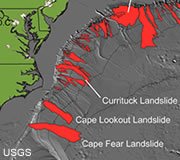
Turbidity Current
A mixture of sediment particles and water that flows down the continental slope. These high-density currents can reach great speeds and generally erode loose sediments from the seafloor beneath them. The image is a map of submarine landslides on the east coast of the United States that probably produced turbidity currents.

Turbulent Flow
An irregular state of fluid flow in which the particle paths cross one another and may even travel in opposing directions. (Compare with Laminar Flow.)
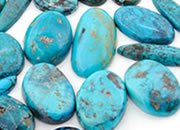

Turritella Agate
Decades ago, this agate was named "Turritella" after the fossil snails that it contains. That name is incorrect because the snails were misidentified. The proper name should be "Elimia agate" after the snail Elimia tenera. Because the name "turritella" is so engrained in common usage, most people do not realize that it is incorrect.

Two-Phase Inclusion
A void within a mineral that contains: A) a liquid and a gas bubble, B) a liquid and a mineral grain, or, C) gas and a mineral grain. The photo shows an inclusion in quartz that contains a liquid and a vapor bubble. The letter "L" indicates the liquid, and the "V" indicates the vapor bubble.
|
| More General Geology |
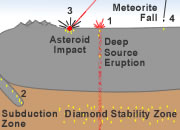 |
Diamonds from Coal? |
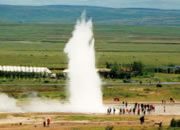 |
What is a Geyser? |
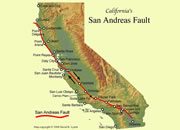 |
What is the San Andreas Fault? |
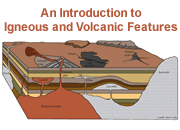 |
Igneous and Volcanic Features |
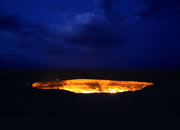 |
The Doorway to Hell |
 |
Topo Maps |
 |
Geology Dictionary |
 |
Gifts That Rock |

Find Other Topics on Geology.com:

|

| ||

|

| ||

|

| ||

|

|

